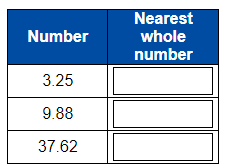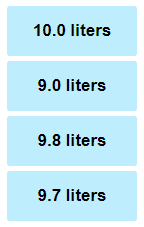
Rounding Decimals
Concept
Rounding Numbers means adjusting the digits of a number in such a way that it gives an approximate value. This value is an easier representation of the given number.
Rounding a number means the process of making a number simpler such that its value remains close to what it was. The result obtained after rounding off a number is less accurate, but easier to use. While rounding a number, we consider the place value of digits in a number.
A decimal number is a combination of a whole number part and a fractional part separated by a decimal point. Rounding decimal numbers works in the same way as we round whole numbers although we need to know the decimal place values of all the digits in the given number. This refers to the digits given before the decimal point as well as the digits given after the decimal point.
Rules
Rules for Rounding Decimals
When rounding a decimal number, you first need to ask: what are you rounding it to? Numbers can be rounded to the nearest whole number, the nearest tenths, the nearest hundredths, the nearest thousandths, and so on.
We first need to know what our rounding digit is. This digit is the one that will ultimately be affected.
After this, we need to check the digit to the right of this place which will decide the fate of the rounding digit.
If the number you are rounding is followed by 0, 1, 2, 3, or 4, we do not change the rounding digit. However, all the digits to the right of the rounding digit are changed to 0.
If the number you are rounding is followed by 5, 6, 7, 8, or 9, we increase the rounding digit by 1, and all the digits to the right of the rounding digit are changed to 0.
Rounding to the nearest whole number:
To round a number to the nearest whole number, you have to look at the first digit after the decimal point. If this digit is less than 5 (1, 2, 3, 4) we don’t have to do anything, but if the digit is 5 or greater (5, 6, 7, 8, 9) we must round up.
Rounding to the nearest tenths:
To round a number to the nearest tenth, look at the next place value to the right (the hundredths). If it’s 4 or less, just remove all the digits to the right. If it’s 5 or greater, add 1 to the digit in the tenths place, and then remove all the digits to the right.
Rounding to the nearest hundredths:
To round a number to the nearest hundredths, look at the next place value to the right (the thousandths). If it’s 4 or less, just remove all the digits to the right. If it’s 5 or greater, add 1 to the digit in the tenths place, and then remove all the digits to the right.
Example
Round 0.249 to the nearest hundredths.
Solution
In this case, the digit to the right of the hundredths place, that is, the thousandths place is 9, which is more than 5. So, we will add 1 to the digit in the hundredths place, that is, 4 + 1 = 5, and write 0 in the digits to the right. So, 0.249 will be rounded to 0.25.
Practice Rounding Decimals

Place value – is the value of each digit in a number.
Rounding a number means the process of making a number simpler such that its value remains close to what it was.




